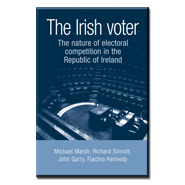Posted: 10 June 2008
Motives, outlooks and behaviour of the Irish Voter
There is considerable potential for local candidates, and short-term forces like leaders and government performance, to have a big impact on voter’s choice in Ireland, according to Professor Richard Sinnott from the UCD School of Politics and International Relations, one of the authors of a new book which investigates the motives, outlook and behaviour of voters in the Republic of Ireland.
In The Irish Voter, Professor Sinnott and his co-authors argue that the Irish case combines an electoral system that gives candidates a strong incentive to campaign for and develop a ‘personal vote’ with a party system that is increasingly independent of stable social and psychological underpinnings. Professor Sinnott emphasises the significance of the finding that party identification has declined by some 30 percentage points since the early 1980s, making Ireland one of the countries with the lowest level of such identification in Europe.
Measuring class and other socio-demographic and attitudinal measures associated with voting behaviour, The Irish Voter reinforces the longstanding view that Irish parties are without social basis.
“There are differences between the three main parties, Fianna Fail, Fine Gael and Labour, in terms of the educational levels of their voters, and there are some urban-rural contrasts, but, in purely social class terms, they are all very similar,” says Professor Sinnott. “However, the qualification must be added that the newer members of the party system are less broadly based.”
“The Progressive Democrats, Greens and Sinn Fein all appeal more to some social groups than to others, although these parties are not quite so sectional as may sometimes be believed.”
In the most comprehensive exploration of divisions over ideologies and values between Irish parties to date, The Irish Voter shows that the basis for party competition on an ideological or value dimension is limited.
According to The Irish Voter, there is some potential for partisan conflict on the secular-religious dimension, best manifest by views on abortion, which are quite polarised. Voters do vary on such issues, but the parties do not, arguably because the institution of the referendum has allowed this issue to be dealt with outside the party system.
“The one issue on which there is a gulf between the parties and the voters is the environment. The voters, who are far more environmentalist than most of the parties, see little difference in the party system on this issue, the Greens being the major exception in this regard,” says Professor Sinnott.
The Irish Voter, published by Manchester University Press, uses the results from the first ever full-scale Irish election survey (Irish National Election Study (INES) 2002) to explore long-term influences on vote choice, such as party loyalties and enduring values, as well as short-term ones, such as the economy, the party leaders and the local candidates. It pays close attention to the way in which PR-STV allows the voter an unusual degree of freedom in choosing between candidates and the consequent very strong candidate-orientation among voters. It also notes the low level of attachment to parties and the often obscure differences between them. And, faced with a substantial decline in turnout over preceding decades, the book provides a new and comprehensive analysis of voter turnout and abstention.
The Irish Voter, was co-authored by Professor Richard Sinnott, University College Dublin; Professor Michael Marsh, Trinity College Dublin; Dr John Garry, Queen’s University Belfast; and Dr Fiachra Kennedy, formerly of the UCD Geary Institute, University College Dublin.
The research reported in The Irish Voter was supported by the Programme for Research in Third- level institutions (PRTLI) and by research awards from the Irish Council for the Humanities and Social Sciences.

